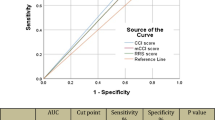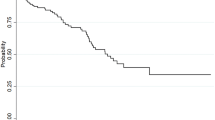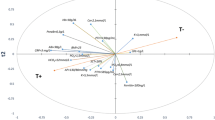Abstract
The aim of this study was to relate in-hospital mortality (IHM), cardiovascular events (CVEs) and non-immunologic comorbidity evaluated on the basis of International Classification of Diseases, 9th Revision, Clinical Modification (ICD-9-CM) codification, in Italian kidney transplant recipients (KTRs). We evaluated IHM and admissions due to CVEs between 2000 and 2013 recorded in the database of the region Emilia Romagna. The Elixhauser score was calculated for evaluation of non-immunologic comorbidity. Three main outcomes (i.e. IHM, admission due to major CVEs and combined outcome) were the dependent variables of the multivariate models, while age, gender and Elixhauser score were the independent ones. During the examined period, a total of 9063 admissions in 3648 KTRs were recorded; 1945 patients were males (53.3 %) and 1703 females (46.7 %) and the mean age was 52.9 ± 13.1 years. The non-immunological impaired status of the KTRs, examined by the Elixhauser score, was 3.88 ± 4.29. During the 14-year follow-up period, IHM for any cause was 3.2 % (n = 117), and admissions due to CVEs were 527 (5.8 %). Age and comorbidity were independently associated with CVEs, IHM and the combined outcome. Male gender was independently associated with IHM and combined outcome, but not with CVEs. Evaluation of non-immunological comorbidity is important in KTRs and identification of high-risk patients for major clinical events could improve outcome. Moreover, comorbidity could be even more important in chronic kidney disease patients who are waiting for a kidney transplant.



Similar content being viewed by others
References
Alonso A, Oliver J (2004) Chronic allograft nephropathy: causes of death and mortality risk factors-a review of the last decade in Spain. Transplant Proc 36:765–767
Liefeldt L, Budde K (2010) Risk factors for cardiovascular disease in renal transplant recipients and strategies to minimize risk. Transpl Int 23:1191–1204
Dimeny EM (2002) Cardiovascular disease after renal transplantation. Kidney Int 61:S78–S84
Kasiske BL, Chakkera HA, Roel J (2000) Explained and unexplained ischemic heart disease risk after renal transplantation. J Am Soc Nephrol 11:1735–1743
Lindholm A, Albrechtsen D, Frodin L et al (1995) Ischemic heart disease—major cause of death and graft loss after renal transplantation in Scandinavia. Transplantation 60:451–457
Ojo AO, Hanson JA, Wolfe RA et al (2000) Long-term survival in renal transplant recipients with graft function. Kidney Int 57:307–313
Wolfe RA, Ashby VB, Milford EL et al (1999) Comparison of mortality in all patients on dialysis, patients on dialysis awaiting transplantation, and recipients of a first cadaveric transplant. N Engl J Med 341:1725–1730
Kasiske BL, Israni AK, Snyder JJ, Skeans MA (2011) Patient Outcomes in Renal Transplantation (PORT) Investigators. The relationship between kidney function and long-term graft survival after kidney transplant. Am J Kidney Dis 57:466–475
Parfrey PS, Harnett JD, Foley RN et al (1995) Impact of renal transplantation on uremic cardiomyopathy. Transplantation 60:908–914
Hernandez D, Lacalzada J, Rufino M et al (1997) Prediction of left ventricular mass changes after renal transplantation by polymorphism of the angiotensin-converting enzyme gene. Kidney Int 51:1205–1211
Peteiro J, Alvarez N, Calvino R et al (1994) Changes in left ventricular mass and filling after renal transplantation are related to changes in blood pressure: an echocardiographic and pulsed Doppler study. Cardiology 85:273–283
Hüting J (1992) Course of left ventricular hypertrophy and function in end-stage renal disease after renal transplantation. Am J Cardiol 70:1481–1484
Himelman RB, Landzberg JS, Simonson JS et al (1988) Cardiac consequences of renal transplantation: changes in left ventricular morphology and function. J Am Coll Cardiol 12:915–923
Neale J, Smith AC (2015) Cardiovascular risk factors following renal transplant. World J Transplant 24(5):183–195
Sarnak MJ, Levey AS (2000) Cardiovascular disease and chronic renal disease: a new paradigm. Am J Kidney Dis 35(4 Suppl 1):S117–S131
Jensik SC (1998) Tacrolimus (FK 506) in kidney transplantation: three-year survival results of the US multicenter, randomized, comparative trial. FK 506 Kidney Transplant Study Group. Transplant Proc 30:1216–1218
Midvedt K, Neumayer HH (2003) Management strategies for posttransplant hypertension. Transplantation 70(11 Suppl):SS64–SS69
Fellström B (2000) Impact and management of hyperlipidemia posttransplantation. Transplantation 70(11 Suppl):SS51–SS57
Jindal RM, Hjelmesaeth J (2000) Impact and management of posttransplant diabetes mellitus. Transplantation 70(11 Suppl):SS58–SS63
Fabbian F, Pala M, De Giorgi A et al (2013) In-hospital mortality in patients with renal dysfunction admitted for myocardial infarction: the Emilia-Romagna region of Italy database of hospital admissions. Int Urol Nephrol 45:769–775
Fabbian F, Gallerani M, Pala M et al (2014) Association between in-hospital mortality and renal dysfunction in 186,219 patients hospitalized for acute stroke in the Emilia-Romagna region of Italy. Angiology 65:906–910
Fabbian F, Gallerani M, Pala M et al (2013) In-hospital mortality for pulmonary embolism: relationship with chronic kidney disease and end-stage renal disease. The hospital admission and discharge database of the Emilia Romagna region of Italy. Intern Emerg Med 8:735–740
Terasaki PI (2003) Deduction of the fraction of immunologic and non-immunologic failure in cadaver donor transplant. Clin transpl 449–452
Elixhauser A, Steiner C, Harris DR, Coffey RM (1998) Comorbidity measures for use with administrative data. Med Care 36:8–27
Quan H, Sundararajan V, Halfon P et al (2005) Coding algorithms for defining comorbidities in ICD-9-CM and ICD-10 administrative data. Med Care 43:1130–1139
Paterno F, Wilson GC, Wima K et al (2014) Hospital utilization and consequences of readmissions after liver transplantation. Surgery 156:871–878
Hernández D, de la Nuez PC, Muriel A et al (2014) Clinical assessment of mortality risk in renal transplant candidates in Spain. Transplantation 98:653–659
Daratha KB, Short RA, Corbett CF et al (2012) Risks of subsequent hospitalization and death in patients with kidney disease. Clin J Am Soc Nephrol 7:409–416
Segev DL, Kucirka LM, Oberai PC et al (2009) Age and comorbidities are effect modifiers of gender disparities in renal transplantation. J Am Soc Nephrol 20:621–628
Wu C, Evans I, Joseph R et al (2005) Comorbid conditions in kidney transplantation: association with graft and patient survival. J Am Soc Nephrol 16:3437–3444
Baskin-Bey ES, Kremers W, Nyberg SL (2007) A recipient risk score for deceased donor renal allocation. Am J Kidney Dis 49:284–293
Karim A, Farrugia D, Cheshire J et al (2014) Recipient age and risk for mortality after kidney transplantation in England. Transplantation 97:832–838
Grosso G, Corona D, Mistretta A et al (2012) Predictive value of the Charlson comorbidity index in kidney transplantation. Transplant Proc 44:1859–1863
USRDS (2011) Transpantation. http://www.usrds.org/2011/pdf/v2_ch07_11.pdf. Accessed 25 Sept 2015
Meier-Kriesche HU, Baliga R, Kaplan B (2003) Decreased renal function is a strong risk factor for cardiovascular death after renal transplantation. Transplantation 75:1291–1295
Israni AK, Snyder JJ, Skeans MA et al (2010) Predicting coronary heart disease after kidney transplantation: patient outcomes in Renal Transplantation (PORT) Study. Am J Transplant 10:338–353
Weiner DE, Carpenter MA, Levey AS et al (2012) Kidney function and risk of cardiovascular disease and mortality in kidney transplant recipients: the FAVORIT trial. Am J Transplant 12:2437–2445
Jardine AG, Fellström B, Logan JO et al (2005) Cardiovascular risk and renal transplantation: post hoc analyses of the Assessment of Lescol in Renal Transplantation (ALERT) Study. Am J Kidney Dis 46:529–536
Machnicki G, Pinsky B, Takemoto S et al (2009) Predictive ability of pretransplant comorbidities to predict long-term graft loss and death. Am J Transplant 9:494–505
Gagne JJ, Glynn RJ, Avorn J, Levin R, Schneeweiss S (2011) A combined comorbidity score predicted mortality in elderly patients better than existing scores. J Clin Epidemiol 64:749–759
Weinhandl ED, Snyder JJ, Israni AK, Kasiske BL (2009) Effect of comorbidity adjustment on CMS criteria for kidney transplant center performance. Am J Transplant 9:506–516
Harhay M, Lin E, Pai A et al (2013) Early rehospitalization after kidney transplantation: assessing preventability and prognosis. Am J Transplant 13:3164–3172
Schultz MA, van Servellen G, Chang BL, McNeese-Smith D, Waxenberg E (1998) The relationship of hospital structural and financial characteristics to mortality and length of stay in acute myocardial infarction patients. Outcomes Manag Nurs Pract 2:130–136
Rosenthal GE (1997) Weak association between hospital mortality rates for individual diagnoses: implications for profiling hospital quality. Am J Public Health 87:429–433
Wallace E, Stuart E, Vaughan N, Bennett K, Fahey T, Smith SM (2014) Risk prediction models to predict emergency hospital admission in community-dwelling adults: a systematic review. Med Care 52:751–765
Athyros VG, Katsiki N, Karagiannis A, Mikhailidis DP (2015) Statins can improve proteinuria and glomerular filtration rate loss in chronic kidney disease patients, further reducing cardiovascular risk. Fact or fiction? Expert Opin Pharmacother 16:1449–1461
Acknowledgments
We thank Franco Guerzoni and Nicola Napoli, Center for Health Statistics, Hospital of Ferrara, for their precious and valuable collaboration. This work has been supported, in part, by a research grant from the University of Ferrara (Fondo Ateneo Ricerca—FAR).
Author information
Authors and Affiliations
Corresponding author
Ethics declarations
Conflict of interest
F. Fabbian, A. De Giorgi, F. Manfredini, N. Lamberti, S. Forcellini, A. Storari, P. Todeschini, M. Gallerani, G. La Manna, R. Manfredini, had no conflict of interest; D. P. Mikhailidis has given talks, attended conferences and participated in advisory boards and trials sponsored by Merck, Sharp & Dohme, AstraZeneca and Libytec. Authors declare that there are not any potential conflicts of interests that are directly or indirectly related to the data presented in the paper.
Statement of human and animal rights
The study was approved by the local institutional committee for human research.
Informed consent
For this type of study formal consent is not required.
Rights and permissions
About this article
Cite this article
Fabbian, F., De Giorgi, A., Manfredini, F. et al. Impact of comorbidity on outcome in kidney transplant recipients: a retrospective study in Italy. Intern Emerg Med 11, 825–832 (2016). https://doi.org/10.1007/s11739-016-1438-2
Received:
Accepted:
Published:
Issue Date:
DOI: https://doi.org/10.1007/s11739-016-1438-2




